Difference between revisions of "Sheep leather"
| Line 5: | Line 5: | ||
== Sheep leather== | == Sheep leather== | ||
| − | In the world there are about 1.2 billion sheep and lambs. 15 to 25% of these are slaughtered annually. Sheep leather, [[lamb leather]] and [[Sheepskin - Lambskin|lambskin]] are second behind [[cow leather]] with about 10% of world production. 90% of the sheep are woolly sheep. The | + | In the world, there are about 1.2 billion sheep and lambs. 15 to 25% of these are slaughtered annually. Sheep leather, [[lamb leather]] and [[Sheepskin - Lambskin|lambskin]] are second behind [[cow leather]] with about 10% of world production. 90% of the sheep are woolly sheep. The finer and denser the wool is, the thinner and worse is the [[leather quality]]. Sheep leather is used for [[Leather book cover|book covers]], [[leather clothing|clothing]], [[leather gloves|gloves]], [[leather accessories]] and occasional for [[leather furniture|furniture]]. |
Italy is by far the largest [[leather production|producer]] of sheep and [[Goatskin|goat]] leather in Europe. Almost 34 million square meters of sheep and goat leather were produced in Italy in 2011. In the same period, almost 100 million square meters of [[cow leather|bovine leather]] were produced in Italy. Germany, the [[leather industry|third-largest leather producer]] after Spain in Europe, produces approximately 500,000 square meters of sheep and goat leather in the same year and approximately 8.5 million square meters of [[cow leather]]. | Italy is by far the largest [[leather production|producer]] of sheep and [[Goatskin|goat]] leather in Europe. Almost 34 million square meters of sheep and goat leather were produced in Italy in 2011. In the same period, almost 100 million square meters of [[cow leather|bovine leather]] were produced in Italy. Germany, the [[leather industry|third-largest leather producer]] after Spain in Europe, produces approximately 500,000 square meters of sheep and goat leather in the same year and approximately 8.5 million square meters of [[cow leather]]. | ||
| Line 24: | Line 24: | ||
<p> </p> | <p> </p> | ||
| − | Sheepskin is related in its structure to [[goatskin]], but less [[leather quality|resistant]]. | + | Sheepskin is related in its structure to [[goatskin]], but less [[leather quality|resistant]]. Sheep are raised for the production of wool. There are countless varieties of skin with considerable differences in [[leather quality|skin quality]]. Even with the same breed, there can be considerable differences due to the environmental conditions (climate, environment, food). |
Revision as of 20:39, 11 February 2017
Sheep leather
In the world, there are about 1.2 billion sheep and lambs. 15 to 25% of these are slaughtered annually. Sheep leather, lamb leather and lambskin are second behind cow leather with about 10% of world production. 90% of the sheep are woolly sheep. The finer and denser the wool is, the thinner and worse is the leather quality. Sheep leather is used for book covers, clothing, gloves, leather accessories and occasional for furniture.
Italy is by far the largest producer of sheep and goat leather in Europe. Almost 34 million square meters of sheep and goat leather were produced in Italy in 2011. In the same period, almost 100 million square meters of bovine leather were produced in Italy. Germany, the third-largest leather producer after Spain in Europe, produces approximately 500,000 square meters of sheep and goat leather in the same year and approximately 8.5 million square meters of cow leather.
The hair pores in sheep leather.
For furniture, solid sheep leather with smooth surfaces are processed.
Sheepskin is related in its structure to goatskin, but less resistant. Sheep are raised for the production of wool. There are countless varieties of skin with considerable differences in skin quality. Even with the same breed, there can be considerable differences due to the environmental conditions (climate, environment, food).
Furniture made of sheep leather is rare. Sheep leather furniture is then processed as patinated, porous aniline leather.
Typical sheep leather furniture.
A special method to increase the grain structure of the sheep's leather is the shrinkage of the leather. This method is used in France, where the leather is called "Basane de Mouton". It is a vegetable-tanned leather. Sheepskins are selected with a strong grain at the neck, which is called "moutonage". It is similar to the neck leather of cattle.
shrunken sheep leather (www.brocantique.de).
Additional information









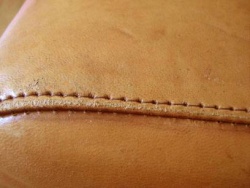
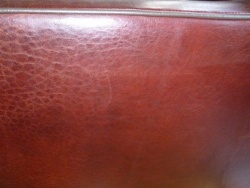
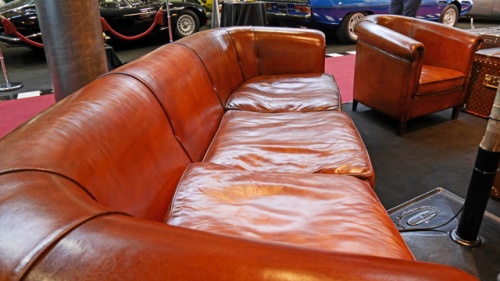
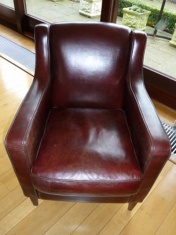
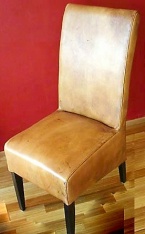
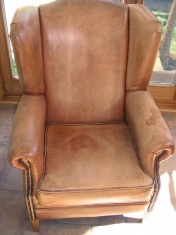
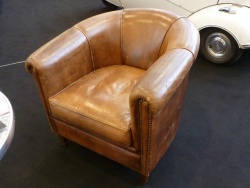
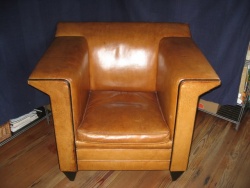
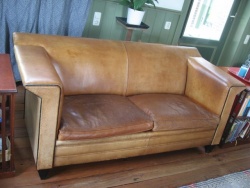
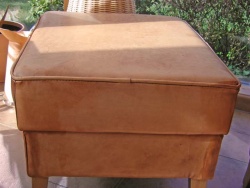
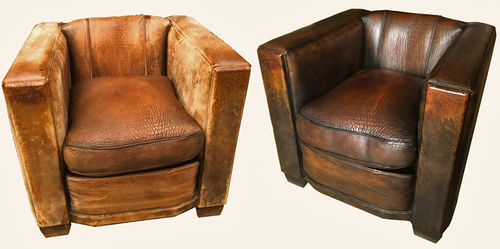

 a kotori web solution
a kotori web solution